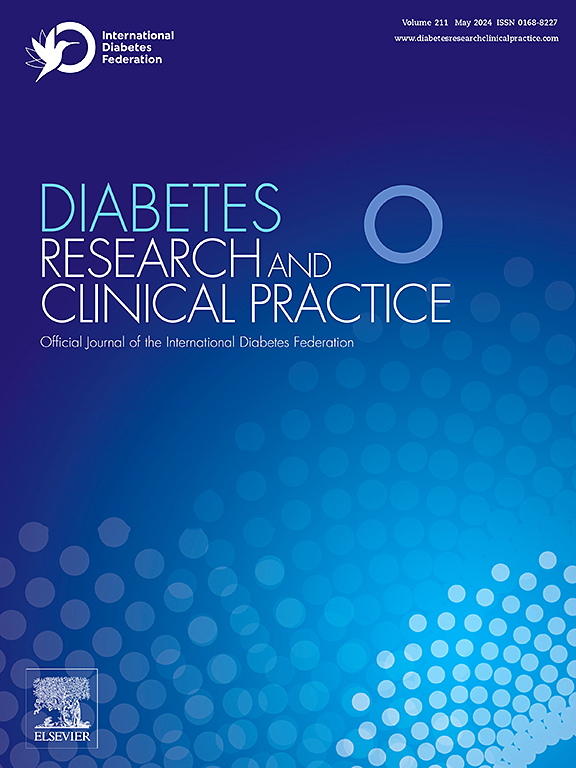Assessment of basal insulin adherence in people with type 2 diabetes in telemonitoring: Post-hoc analysis of novel data modalities including insulin injection data
IF 6.1
3区 医学
Q1 ENDOCRINOLOGY & METABOLISM
引用次数: 0
Abstract
Aims
Adherence in people with insulin-treated type 2 diabetes (T2D) is not well understood despite it being a prerequisite for preventing complications. This study used insulin injection data from connected insulin pens to examine adherence and characteristics of people with insulin-treated T2D in telemonitoring.
Methods
Data from 165 participants were included. We applied a three-step methodology to assess overall adherence, adherence distribution, and dose deviation, using injection data recorded by a connected insulin pen. Additionally, statistical tests were performed to evaluate differences in characteristics between adherent and non-adherent participants.
Results
Weekly averaged overall adherence levels ranged between 70.6 % and 79.3 %. Deviation from the recommended dose occurred in 98.8 % of participants, primarily as increased or reduced doses. Non-adherent participants had higher HbA1c (OR = 0.96, 95 % CI = 0.93, 0.99), and total daily insulin dose (OR = 0.99, 95 % CI = 0.98, 0.99), and a lower level of physical activity (OR = 2.55, 95 % CI = 1.23, 5.28) compared to adherent participants.
Conclusions
Utilizing insulin injection data our results provide detailed insights into basal insulin adherence behavior, including irregularities and daily dose adjustments. Our findings are necessary for supporting healthcare providers’ preventable efforts and optimizing diabetes care.
远程监测中2型糖尿病患者基础胰岛素依从性的评估:包括胰岛素注射数据在内的新数据模式的事后分析
目的:胰岛素治疗2型糖尿病(T2D)患者的依从性尚不清楚,尽管它是预防并发症的先决条件。本研究使用连接胰岛素笔的胰岛素注射数据,在远程监测中检查胰岛素治疗的t2dm患者的依从性和特征。方法纳入165名参与者的资料。我们采用三步方法评估总体依从性、依从性分布和剂量偏差,使用连接胰岛素笔记录的注射数据。此外,还进行了统计检验来评估依从性和非依从性参与者之间的特征差异。结果每周平均总体依从性在70.6%至79.3%之间。98.8%的参与者偏离了推荐剂量,主要是增加或减少剂量。与坚持治疗的患者相比,非坚持治疗的患者HbA1c较高(OR = 0.96, 95% CI = 0.93, 0.99),每日胰岛素总剂量较高(OR = 0.99, 95% CI = 0.98, 0.99),体力活动水平较低(OR = 2.55, 95% CI = 1.23, 5.28)。结论利用胰岛素注射数据,我们的研究结果提供了基础胰岛素依从性行为的详细见解,包括不规则性和每日剂量调整。我们的发现对于支持医疗保健提供者的可预防努力和优化糖尿病护理是必要的。
本文章由计算机程序翻译,如有差异,请以英文原文为准。
求助全文
约1分钟内获得全文
求助全文
来源期刊

Diabetes research and clinical practice
医学-内分泌学与代谢
CiteScore
10.30
自引率
3.90%
发文量
862
审稿时长
32 days
期刊介绍:
Diabetes Research and Clinical Practice is an international journal for health-care providers and clinically oriented researchers that publishes high-quality original research articles and expert reviews in diabetes and related areas. The role of the journal is to provide a venue for dissemination of knowledge and discussion of topics related to diabetes clinical research and patient care. Topics of focus include translational science, genetics, immunology, nutrition, psychosocial research, epidemiology, prevention, socio-economic research, complications, new treatments, technologies and therapy.
 求助内容:
求助内容: 应助结果提醒方式:
应助结果提醒方式:


